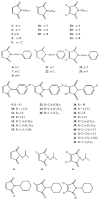Anti-Leishmanial and Cytotoxic Activities of a Series of Maleimides: Synthesis, Biological Evaluation and Structure-Activity Relationship
- PMID: 30400596
- PMCID: PMC6278306
- DOI: 10.3390/molecules23112878
Anti-Leishmanial and Cytotoxic Activities of a Series of Maleimides: Synthesis, Biological Evaluation and Structure-Activity Relationship
Abstract
In the present study, 45 maleimides have been synthesized and evaluated for anti-leishmanial activities against L. donovani in vitro and cytotoxicity toward THP1 cells. All compounds exhibited obvious anti-leishmanial activities. Among the tested compounds, there were 10 maleimides with superior anti-leishmanial activities to standard drug amphotericin B, and 32 maleimides with superior anti-leishmanial activities to standard drug pentamidine, especially compounds 16 (IC50 < 0.0128 μg/mL) and 42 (IC50 < 0.0128 μg/mL), which showed extraordinary efficacy in an in vitro test and low cytotoxicities (CC50 > 10 μg/mL). The anti-leishmanial activities of 16 and 42 were 10 times better than that of amphotericin B. The structure and activity relationship (SAR) studies revealed that 3,4-non-substituted maleimides displayed the strongest anti-leishmanial activities compared to those for 3-methyl-maleimides and 3,4-dichloro-maleimides. 3,4-dichloro-maleimides were the least cytotoxic compared to 3-methyl-maleimides and 3,4-non-substituted maleimides. The results show that several of the reported compounds are promising leads for potential anti-leishmanial drug development.
Keywords: Leishmania donovani; SAR; anti-leishmanial activity; cytotoxicity; maleimides.
Conflict of interest statement
The authors declare no conflict of interest.
Figures




Similar articles
-
Design, synthesis and biological evaluation of piperazinyl-β-carbolinederivatives as anti-leishmanial agents.Eur J Med Chem. 2018 Apr 25;150:559-566. doi: 10.1016/j.ejmech.2018.03.022. Epub 2018 Mar 8. Eur J Med Chem. 2018. PMID: 29549840
-
Biological evaluation and structure activity relationship of 9-methyl-1-phenyl-9H-pyrido[3,4-b]indole derivatives as anti-leishmanial agents.Bioorg Chem. 2019 Mar;84:98-105. doi: 10.1016/j.bioorg.2018.11.037. Epub 2018 Nov 22. Bioorg Chem. 2019. PMID: 30500524 Free PMC article.
-
Synthesis and evaluation of novel triazolyl quinoline derivatives as potential antileishmanial agents.Eur J Med Chem. 2018 Jun 25;154:172-181. doi: 10.1016/j.ejmech.2018.05.014. Epub 2018 May 12. Eur J Med Chem. 2018. PMID: 29793211
-
A comprehensive review of chalcone derivatives as antileishmanial agents.Eur J Med Chem. 2018 Apr 25;150:920-929. doi: 10.1016/j.ejmech.2018.03.047. Epub 2018 Mar 22. Eur J Med Chem. 2018. PMID: 29602038 Review.
-
Leishmania treatment and prevention: Natural and synthesized drugs.Eur J Med Chem. 2018 Dec 5;160:229-244. doi: 10.1016/j.ejmech.2018.10.022. Epub 2018 Oct 11. Eur J Med Chem. 2018. PMID: 30342363 Review.
Cited by
-
Antifungal activity of a maleimide derivative: disruption of cell membranes and interference with iron ion homoeostasis.Mycology. 2024 Mar 19;16(1):382-401. doi: 10.1080/21501203.2024.2330403. eCollection 2025. Mycology. 2024. PMID: 40083407 Free PMC article.
-
Biochemical characterization and chemical validation of Leishmania MAP Kinase-3 as a potential drug target.Sci Rep. 2019 Nov 7;9(1):16209. doi: 10.1038/s41598-019-52774-6. Sci Rep. 2019. PMID: 31700105 Free PMC article.
-
Computational design, molecular properties, ADME, and toxicological analysis of substituted 2,6-diarylidene cyclohexanone analogs as potent pyridoxal kinase inhibitors.In Silico Pharmacol. 2023 Mar 23;11(1):6. doi: 10.1007/s40203-023-00142-8. eCollection 2023. In Silico Pharmacol. 2023. PMID: 36968686 Free PMC article.
-
Inhibitory effects of a maleimide compound on the virulence factors of Candida albicans.Virulence. 2023 Dec;14(1):2230009. doi: 10.1080/21505594.2023.2230009. Virulence. 2023. PMID: 37367101 Free PMC article.
-
Advances in organocatalyzed synthesis of organic compounds.RSC Adv. 2024 Jun 25;14(28):20365-20389. doi: 10.1039/d4ra03046j. eCollection 2024 Jun 18. RSC Adv. 2024. PMID: 38919284 Free PMC article. Review.
References
-
- World Health Organization. [(accessed on 1 September 2017)]; Available online: www.who.int/leishmaniasis/burden/en/
-
- Sharma U., Singh S. Immunobiology of leishmaniasis. Indian J. Exp. Biol. 2009;47:412–423. - PubMed
MeSH terms
Substances
LinkOut - more resources
Full Text Sources
Miscellaneous

